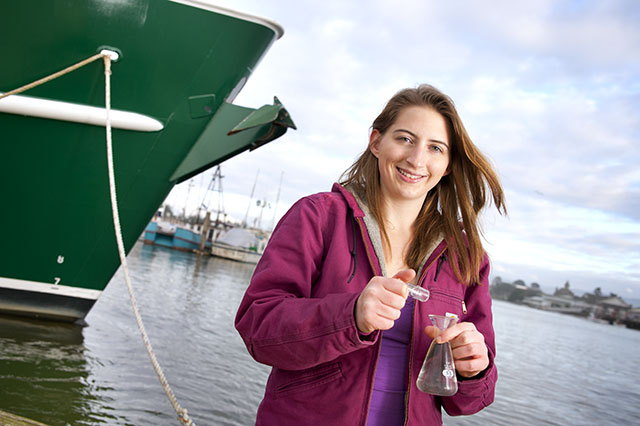
Vanessa’s decision to come to Humboldt State was partly motivated by her grandfather, George Crandell, who taught oceanography here in the 1970s. She followed in his footsteps a few decades later, double majoring in oceanography and geology.
This winter, Vanessa had the opportunity to put her geoscience skills to use aboard the R.V. Melville, a vessel owned by the U.S. Navy and operated by the Scripps Institution of Oceanography.
For 24 days, she served as a research assistant to Amy Waterhouse and Ruth Musgrave—oceanography post-docs at Scripps. Along with 15 other scientists, she helped collect oceanographic data from Mendocino Ridge and Eel Canyon, just south of Arcata.
Waterhouse and Musgrave are studying how internal waves—waves that oscillate underwater as opposed to above water—are generated and propagate off the California coast.
Internal waves are important to geoscience because they can impact the Earth’s climate, affect plankton distribution and shape continental slopes, according to the Massachusetts Institute of Technology. They also affect underwater technology, communication and submersible vehicles, according to MIT.
Vanessa had some prior research experience aboard the R.V. Coral Sea, HSU’s marine research and teaching vessel. But she said that nothing compared to the first time she saw the Melville, a 279-foot long ship that accommodates a crew of 23. “I was in awe,” she recalls.
The three week trip started below the Mendocino Ridge and wound north to Eel Canyon. At various points along the way, Vanessa was responsible for dropping moorings and instruments into the ocean to measure conductivity, temperature and depth. She worked on a team of mostly post-docs that included scientists from Chile, Norway and Mexico. “We’d be out there at various times 24-hours-a-day to get readings,” she says.
Waterhouse and Musgrave will use data from the Mendocino Ridge and Eel Canyon trip to help explain the creation and propagation of internal waves off the Pacific Coast. They’ll eventually present their findings around the country.
For Vanessa, it was a once-in-a-lifetime research experience. It also opened her eyes to career possibilities in the geosciences. Her goals include pursuing a master’s degree in volcanology—the study of volcanoes—and joining the staff of another oceangoing vessel, the JOIDES Resolution. The JR is the only ship in America that drills into the sea floor to collect samples of the Earth. Scientists use the samples to better understand the Earth’s development and past.
“The ultimate goal is to reach the Earth’s mantle,” says Vanesssa, which is roughly 3,000 kilometers below the ocean floor. So far, the JR has drilled a hole 2,100 meters deep. “It’s a long way to go,” Vanessa says, “but it’s possible.”